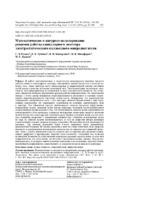| dc.contributor.author | Редько, С. В. | |
| dc.contributor.author | Чубенко, E. Б. | |
| dc.contributor.author | Бондаренко, В. П. | |
| dc.contributor.author | Никифоров, И. В. | |
| dc.contributor.author | Краков, М. С. | |
| dc.coverage.spatial | Минск | ru |
| dc.date.accessioned | 2024-07-01T09:22:00Z | |
| dc.date.available | 2024-07-01T09:22:00Z | |
| dc.date.issued | 2024 | |
| dc.identifier.citation | Математическое и натурное моделирование режимов работы капиллярного эмиттера электростатического коллоидного микродвигателя = Mathematical and Experimental Simulation of Operating Modes of Capillary Emitter of Electrostatic Colloidal Microthruster / С. В. Редько [и др.] // Известия высших учебных заведений и энергетических объединений СНГ. Энергетика. – 2024. – № 3. – С. 193-208. | ru |
| dc.identifier.uri | https://rep.bntu.by/handle/data/145782 | |
| dc.description.abstract | В работе экспериментально и теоретически анализируется динамика процесса эмиссии ионов из капиллярного эмиттера, заполненного ионной жидкостью в качестве рабочего тела. Такие эмиттеры могут использоваться в энергетической системе спутников малой массы в качестве источника реактивной тяги. Экспериментально исследована зависимость тяги микродвигателя от подаваемой на него электрической мощности, что позволило определить наиболее эффективные режимы работы микродвигателя. Это представляет интерес с точки зрения повышения энергоэффективности последнего в условиях ограниченной энерговооруженности спутников малой массы. Обнаружено, что характеристика «напряжение электрического поля – тяга эмиттера» является немонотонной с ярко выраженным максимумом, что накладывает ограничения на величину электрического поля в эмиттере. Для объяснения предела интенсивности эмиссии построена диффузионно-конвективная модель движения ионов внутри капилляра. Основной идеей предложенной модели является предположение о том, что интенсивность эмиссии ионов определяется их концентрацией в устье капилляра, а скорость эмитируемых ионов выше скорости движения ионной жидкости в капилляре как сплошной среды. Причем ускорение ионов в устье эмиттера нелинейно возрастает с повышением внешних сил. Снижение концентрации ионов по мере их эмиссии должно компенсироваться за счет их диффузии внутри капилляра и конвективных потоков, скорость которых ограничена. Построенная модель анализируется численно. Для системы уравнений Навье – Стокса применена схема расщепления, предложенная Чориным. На каждом временном шаге на основе известного поля скорости, плотности и распределения концентрации делается шаг по времени для уравнений движения. Затем с учетом найденной скорости делается шаг по времени для уравнений конвективной диффузии и производится пересчет поля плотности. Созданный код позволил подтвердить возможность существования максимума массового расхода ионов, то есть тяги микродвигателя, что качественно соответствует экспериментальным данным. Определяющим фактором, от которого зависит величина максимума и его положение, является степень нелинейности коэффициента, ответственного за ускорение ионов на выходе из капилляра. | ru |
| dc.language.iso | ru | ru |
| dc.publisher | БНТУ | ru |
| dc.title | Математическое и натурное моделирование режимов работы капиллярного эмиттера электростатического коллоидного микродвигателя | ru |
| dc.title.alternative | Mathematical and Experimental Simulation of Operating Modes of Capillary Emitter of Electrostatic Colloidal Microthruster | ru |
| dc.type | Article | ru |
| dc.identifier.doi | 10.21122/1029-7448-2024-67-3-193-208 | |
| local.description.annotation | This work experimentally and theoretically analyzes the dynamics of the process of ion emission from a capillary emitter filled with an ionic liquid as a working fluid. Such emitters can be used in the energy system of low-mass satellites as a source of jet propulsion. The dependence of the thrust of a micromotor on the electrical power supplied to it was experimentally studied, which made it possible to determine the most efficient operating modes of the microthruster. This is of interest from the point of view of increasing the energy efficiency of the latter in conditions of limited power availability of low-mass satellites. It was found that the characteristic “electric field voltage – emitter thrust” is non-monotonic with a pronounced maximum, which imposes restrictions on the magnitude of the electric field in the emitter. To explain the limit of emission intensity, a diffusion-convective model of ion movement inside the capillary was constructed. The main idea of the proposed model is the assumption that the intensity of ion emission is determined by their concentration at the outlet of the capillary, and the velocity of the emitted ions is higher than the velocity of flow of the ionic liquid in the capillary as a continuous medium. Moreover, the acceleration of ions at the outlet of the emitter increases nonlinearly with increasing external forces. The decrease in the concentration of ions as they are emitted must be compensated by their diffusion inside the capillary and convective flows, the velocity of which is limited. The constructed system of equations is analyzed numerically. For the system of Navier – Stokes equations, the projection method proposed by Chorin is applied. Based on the known velocity field, density, and concentration distribution, a time step is taken for the equations of motion. Then, taking into account the found velocity, a time step is taken for the convective diffusion equations and the density field is recalculated. The created code made it possible to confirm the possibility of the existence of a maximum mass flow rate of ions, i.e., micromotor thrust, which is in qualitative agreement with the experimental data. The main factor on which the magnitude of the maximum and its position depend is the degree of nonlinearity of the coefficient responsible for the acceleration of ions at the outlet of the capillary. | ru |

